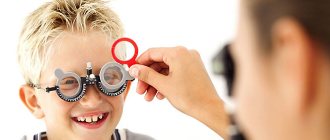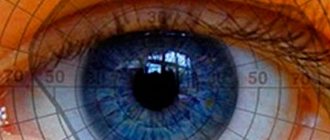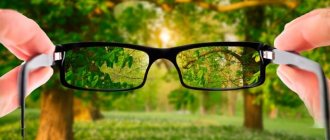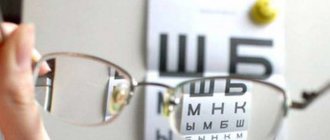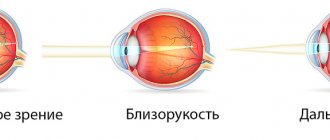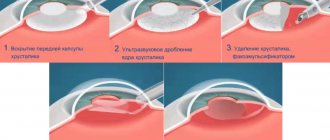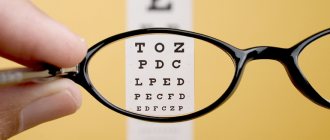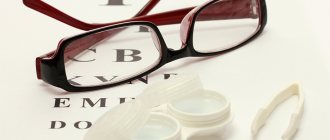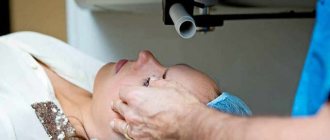Myopia (otherwise “myopia”) is a pathology in which distant objects appear blurry. This is a fairly common disease that is most often corrected with glasses or contacts. However, sometimes myopia is much more serious, so these measures are not enough.
In this article
- What is high myopia?
- Reasons for the development of myopia
- Complications of high myopia
- Correction of complicated high myopia
- High complicated myopia: treatment with surgery
- Laser surgery for moderate and high myopia, as well as lens replacement for high myopia
- Implantation of an intraocular lens
- High degree of myopia and astigmatism
- High myopia and pregnancy
What is high myopia?
With myopia, the eyeball lengthens and the cornea is removed from the back wall of the eye. Because of this, light rays are refracted incorrectly: the image is not focused on the retina, as necessary, but in front of it.
A high degree of myopia is more than -6 diopters. The symptoms of this disease are the same as for other degrees of myopia. People suffer from blurred vision, excessive eye strain, and extreme fatigue when working at a computer or with small objects.
Often there is pain and pain in the eyes, and in order to see objects located at a distance, you have to squint.
Pathogenesis
Myopia, as a rule, develops due to elongation of the anteroposterior axis of the eye, less often due to excessive refractive power of its optical media. The development of myopia is facilitated by increased visual work at close range with weak accommodation (the ability of the eye to see clearly at different distances) and genetic predisposition. When the tunica albuginea is weak, the eyeball gradually stretches, which leads to changes in the choroid and retina. Weakening of accommodation and stretching of the sclera can also occur due to infectious diseases and general intoxication of the body, hormonal changes and metabolic (metabolic) disorders.
Reasons for the development of myopia
Myopia occurs when the shape of the eyeball lengthens and no longer matches the refractive power of the cornea and lens. This is what causes the image to focus in front of the retina.
At present, the exact reasons for changes in the shape of the eyeball have not been established, however, experts have identified a number of factors that cause the appearance of high complicated myopia. So, many people inherit myopia from their parents. Research is also being conducted on the influence of gender and ethnicity, age, place of residence and some other factors on the occurrence of myopia.
Sometimes myopia can occur due to a defect in the shape of the cornea. But in any case, the disease requires an immediate visit to an ophthalmologist. The first symptoms should prompt an examination at the doctor's office. Otherwise, a person will not only experience discomfort in everyday life, but may also suffer serious complications.
Diagnostics
To make a diagnosis of myopia, a number of ophthalmological tests, instrumental and hardware studies are performed:
- checking visual acuity according to the table using trial spectacle lenses - allows you to determine the degree of myopia, but is subjective in nature, and therefore requires additional research;
- skiascopy and refractometry - help to establish the true value of refraction (refractive power of the optical system) of the eyes;
- ophthalmoscopy and biomicroscopy - are carried out to identify the condition of the retina and lens of the eye;
- Ultrasound (ultrasound examination) of the eyes - performed to measure the anteroposterior axis of the eye, the size of the lens, and assess the condition of the vitreous body.
Differential diagnosis for myopia is carried out with false myopia (spasm of accommodation), which occurs due to spasm of the eye muscles, which help the eye focus on distant and near objects.
Complications of high myopia
As a rule, myopia continues to progress until the age of 20-30. After this age, vision stops falling and becomes stationary, so it is best to resort to laser correction in adulthood. If the progression of myopia does not stop, this leads to serious consequences, including blindness.
At the same time, it must be emphasized that complications can also arise with already stabilized myopia, because the shape of the eyeball does not change and remains elongated.
Complications of high myopia:
- Retinal detachment, which can lead to blindness. Elongation of the eyeball and thinning of the retina increase visual strain, causing the retina to tear or detach from the choroid. In such cases, you need to immediately seek medical help to prevent vision loss.
- High intraocular pressure and accompanying glaucoma. This disease also often causes sudden loss of vision.
- Retinal dystrophy - with this complication, the central area of the retina, whose function is to ensure image clarity, is exposed to degenerative processes.
- Cataract is a disease caused by clouding of the lens of the eye, which leads to deterioration of visual acuity.
These complications of high myopia can occur in patients of any gender and age. Problems with the retina can appear even after laser vision correction. This, as mentioned above, is due to the shape of the eyeball, which does not change in any way even during surgery.
Complicated high myopia requires systematic visits to the ophthalmologist's office. A specialist must evaluate the condition of the retina in order to promptly identify its thinning or rupture and take action. If there is a veil or flashes in the eyes, you should immediately consult a doctor. Delay in this case can cost your eyesight.
Types of myopia
Myopia is divided into congenital and acquired or school myopia.
Congenital myopia
Congenital myopia is usually a disease. The diagnosis is made to a child under 1 year of age. The prognosis depends on the severity of the disease and the timeliness of the correct correction. In order for the child’s visual apparatus to develop normally and to preserve visual functions, it is necessary to prescribe correction (glasses or contact lenses) as quickly as possible.
It is to exclude congenital myopia that a child under one year of age should be examined at least three times by an ophthalmologist. Parents should pay attention to the appearance of such signs of congenital myopia as the appearance of strabismus in a child at the age of 3 months; an older child may often rub his eyes or bring toys close to his eyes.
School myopia
The first signs of acquired or school myopia, decreased vision, most often appear in a child at school age, this is due to increased visual load.
If 15-20 years ago the first manifestations of decreased vision were noted at the age of 13-14 years, now cases of myopia in children aged 5-7 years and even at an earlier age of 3-4 years have become much more common.
In recent years, the early appearance of myopia in children has been noted by ophthalmologists not only in Russia, but also abroad.
The main reason for the early manifestation of myopia in children is intense and prolonged eye strain in preschool children associated with the use of tablets, computers, and cell phones.
Correction of complicated high myopia
Correction of high myopia is performed in several ways. The simplest of them is with glasses or contact lenses. And even if lenses are preferred, it’s still worth purchasing glasses: they will help you navigate the space before going to bed and immediately after waking up.
It is worth noting that high complicated myopia is corrected using glasses with high optical power. Their lenses are thicker at the edges and thinner in the center. The higher the diopter, the heavier and thicker they will be. These lenses are not suitable for all frames: they require wide frames, which often cause discomfort when wearing these lenses.
Currently, to create lenses with high corrective power, modern high index materials are used, which have a high refractive ability: they have it much higher than that of simple plastic or glass usually used to create lenses. The higher the index, the thinner the lens - this rule applies even with the same optical power on the eyes. High-refractive lenses are much thinner than standard lenses, making them much more comfortable to wear.
Lenses made of mineral glass have one serious drawback: their weight is directly proportional to the index value. Because of this, they may be thinner than glass ones, but the weight will not differ. Lenses made of polymer materials have significantly less weight and thickness than conventional glass.
It is also worth noting that the most important characteristic of lenses made from materials with high refractive indices is the presence of an anti-reflex coating. Thanks to this, more light is transmitted, and the lenses become more transparent and gain the ability to absorb glare. High refractive lenses can be used for high myopia up to -16 diopters.
It is because of these difficulties that people with high complicated myopia prefer vision correction using contact optics. It does not have the disadvantages inherent in glasses, and a contraindication is an allergy to the materials.
How dangerous is myopia in a child?
Let's start not with the causes, but with the consequences, because the main danger lies precisely in them. The consequences of childhood myopia not identified and corrected in time represent a whole complex of interrelated problems that significantly and irreversibly reduce the child’s quality of life.
In this article we will not talk about the completely visible and immediate danger of myopia in childhood for the human visual system. In most cases, childhood myopia can be identified, stopped and corrected with timely consultation with doctors. Modern ophthalmology in this matter is entirely on the side of parents and offers a whole range of treatment methods: from classical spectacle correction to courses of hardware treatment of childhood myopia using the RELAX computer program and on the VISATRONIK M3 ophthalmic myotrainer-relaxer to the modern method of myopia correction with hard night contact lenses (orthokeratology). More details about these methods can be found in the Pediatric Ophthalmology section.
Here we will dwell on the socio-psychological aspects of childhood myopia, which can also have significant consequences for the child’s health, in addition to a direct threat to visual acuity.
High complicated myopia: treatment with surgery
High complicated myopia is treated with surgery. Methods such as laser vision correction, refractive lens replacement and intraocular lens implantation are used.
Before any of these operations, a study is carried out. The operation cannot be performed if the course of myopia is not stable.
Laser surgery for moderate and high myopia
The most popular type of surgical intervention is laser vision correction, which allows you to work with myopia down to -15 D. The operation is performed without mechanical impact on the cornea, using laser equipment. The scalpel beam vaporizes the corneal tissue. This operation can be performed only if there are indications determined by an ophthalmologist. The decision to perform laser surgery is made based on the results of an individual examination, which helps to exclude contraindications.
High degree of myopia and astigmatism
Quite often, high myopia is accompanied by astigmatism. Moreover, if myopia exceeds -15 D, then there are contraindications for laser correction. How to restore vision in such a situation?
In such cases, specialists combine several types of surgical intervention. First, an intraocular lens is implanted, which helps correct myopia, and then astigmatism is corrected using laser equipment.
Wearing orthokeratology lenses for myopia
Orthokeratological contact lenses are one of the latest developments by ophthalmological scientists. In our country it is not yet as popular as in Europe and the USA. Orthokeratology lenses are often called “night lenses.” This is because optical products only need to be worn while sleeping. This schedule of use allows a person to do without contact optics for the entire next day and see clearly.
Hydrogel and silicone hydrogel materials are not used for the production of night lenses. Orthokeratological contact correction products have a more rigid structure. They consist of two layers. The external one works like a regular daytime lens. The inner layer has a dense structure that allows you to model the shape of the cornea. Orthokeratology lenses are often prescribed for progressive myopia.
The effect of wearing them is achieved by modeling the cornea. They give it a shape that creates all the conditions for the image to focus on the retina. This effect is temporary, so the lenses must be put on again the next night. However, they do not eliminate myopia, but are only one of the ways to correct this refractive error.
High myopia and pregnancy
A high degree of myopia creates additional problems for pregnant women and causes greater risks during childbirth. A woman with this refractive error should be monitored by an ophthalmologist throughout her pregnancy. Also, do not forget about the regularity of visits even after the birth of a child - such prevention will help you notice changes in the visual organs in time and take action.
Many experts are of the opinion that high myopia can cause retinal detachment or damage to the membrane of the eye during the natural birth process. This can happen due to the fact that intraocular pressure increases many times during childbirth.
Because of this, the decision on the method of delivery is often made based on the opinion of an ophthalmologist. If the specialist believes that the condition of the visual organs in the last weeks of pregnancy was satisfactory, then the woman will be able to give birth naturally. It happens that an ophthalmologist prescribes restrictions during the period of pushing, but this method creates a significant threat for both mother and child.
If the retina has already been damaged, then the risk of its detachment or hemorrhage into the eyeball during pushing increases significantly. Then doctors prefer not to take risks and prescribe a caesarean section.
To assess the condition of the retina in cases of high myopia, it is necessary to dilate the pupil using special drops. Then a fundus examination is performed. During it, the ophthalmologist examines the retina in detail for tears and detachments, and looks for the presence of thinned areas.
If you have high myopia, you need to regularly visit an ophthalmologist and monitor your eye condition. Then complications can be avoided.
